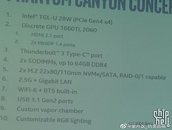Monday, August 12th 2019

Intel "Tiger Lake" Supports PCIe Gen 4 and Features Xe Graphics, Phantom Canyon NUC Detailed
Intel is working on its next generation gaming-grade NUC, codenamed "Phantom Canyon." When it comes out some time in 2020-21, it will feature Intel's 10 nm+ "Tiger Lake" SoC. Intel detailed this and more in a leaked presentation to industry partners. It describes the launch of of the company's "Ghost Canyon" NUC in Fall 2019 to succeed the current "Hades Canyon" gaming NUC. This box features a Core i9-9980HK processor and discrete graphics options. It will be succeeded in 2020-21 (late 2020 or sometime 2021), by the "Phantom Canyon" NUC that's in development.
The "Phantom Canyon" NUC is powered by a 28 W 10 nm+ "Tiger Lake-U" SoC that features PCI-Express gen 4. The package also implements Intel's "Gen 12" graphics processor that's derived from the Xe architecture it's currently working on, according to Chinese publication PTTWeb. The NUC will also feature discrete graphics options in the price-range of the current GTX 1660 Ti and RTX 2060 ($299 to $349). In related news, we see subtle hints that Intel will give its chipset bus a major update in future generations of its desktop and mobile platforms. Apparently, future platforms could feature DMI spread over 8 lanes as opposed to 4 on current platforms, besides the update to PCIe gen 4. This quadrupling in bandwidth compared to DMI 3.0 (PCIe 3.0 x4) is necessitated by the growth in bandwidth-hungry devices such as NVMe SSDs, external Thunderbolt 3 graphics cards, USB 3.2 flash drives, etc.
Sources:
ChipHell, FanlessTech, PTTWeb
The "Phantom Canyon" NUC is powered by a 28 W 10 nm+ "Tiger Lake-U" SoC that features PCI-Express gen 4. The package also implements Intel's "Gen 12" graphics processor that's derived from the Xe architecture it's currently working on, according to Chinese publication PTTWeb. The NUC will also feature discrete graphics options in the price-range of the current GTX 1660 Ti and RTX 2060 ($299 to $349). In related news, we see subtle hints that Intel will give its chipset bus a major update in future generations of its desktop and mobile platforms. Apparently, future platforms could feature DMI spread over 8 lanes as opposed to 4 on current platforms, besides the update to PCIe gen 4. This quadrupling in bandwidth compared to DMI 3.0 (PCIe 3.0 x4) is necessitated by the growth in bandwidth-hungry devices such as NVMe SSDs, external Thunderbolt 3 graphics cards, USB 3.2 flash drives, etc.



22 Comments on Intel "Tiger Lake" Supports PCIe Gen 4 and Features Xe Graphics, Phantom Canyon NUC Detailed
www.techpowerup.com/forums/threads/next-generation-intel-xeon-scalable-processors-to-deliver-breakthrough-platform-performance-with-up-to-56-processor-cores.258004/#post-4093095
For industrial, server etc. purposes - the increased bandwidth is helpful.
What they are talking about here is mobile platform and PCIe 4.0 will probably be the go to bus for mobile devices for a little while.
Although PCIe 5.0 has much better power optimizations so i do not believe they will stay on PCIe 4.0 very long.
Regarding SSD that will change fast, new controllers releasing late 2020 or early 2021 doing up to 8GB/sek and with far more IOPS also nvme 1.4 have some very interesting additions.
Same mambo jambo every time something new is introduced, sure it take a little while before the speed of new standards can be fully realized BUT that is nothing new.
From this article, I understand two things:
1. Apparently you can (will be able to?) do PCIe 4.0 with out a fan on the southbridge.
2. The discrete GPU options do not include Xe.
Ghost Canyon and Quartz Canyon are new desktop style form factor and internal PSU. Phantom Canyon will remain flat with external PSU.
Still think PCIe 3.0 is enough? ;)
You quoted my post starting with "For a normal everyday user..." - that says it all.